From period cups to period underwear, I break down the best reusable menstrual products and brands for a nontoxic, waste-free period in 2024.
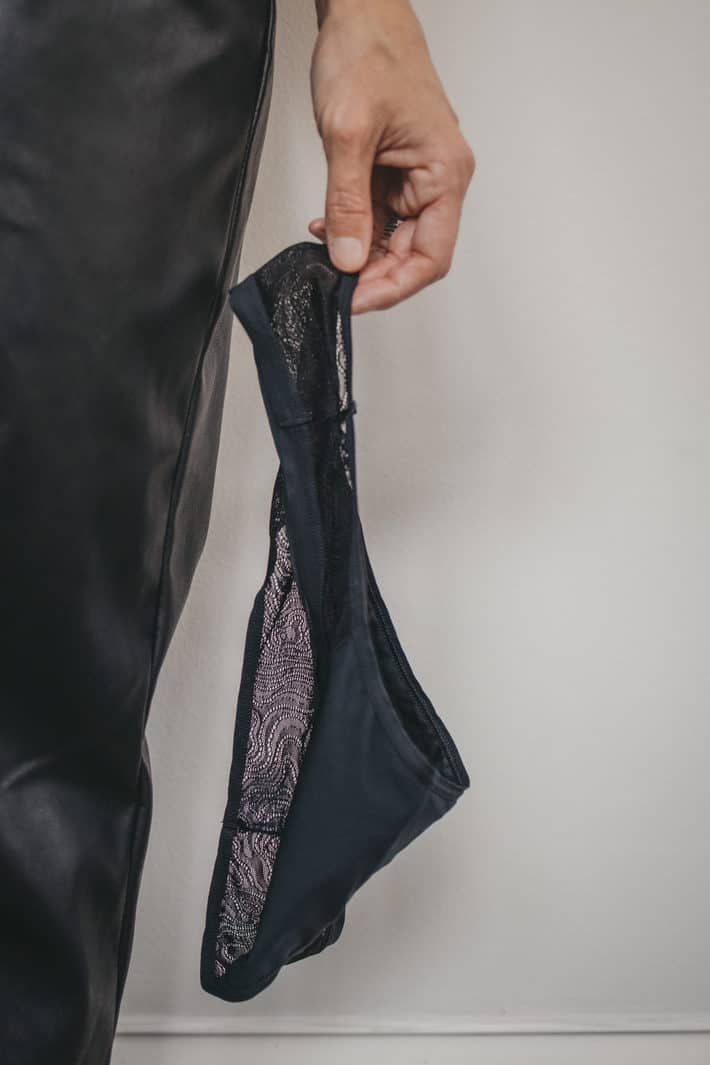
By: Nicolle Mackinnon
If I told you there was a way to make your monthly period more bearable (and planet-friendly), would you want in? Sustainable menstrual care has come a long way since “no applicator” O.B.’s. (PRAISE BE!) With the introduction of period undies and silicone menstrual catch-alls, period care can be a lot easier on the planet and dare I say, easier for us too.
IN THIS POST:
The Impact of Menstrual Products
The big takeaway here is not all menstrual products are created equal. In the last five years, there’s been an emergence of organic, unbleached cotton tampons that are free from pesticides and GMOs. I mean, even Tampax put out an organic tampon in 2019.
Using an organic tampon can make an impact on health, but we can also ante up and make menstrual care choices that have a lighter impact on our planet too. And let’s face it—if there is an alternative to disposable products, we’re in.
But can we really make an impact on the planet by individually practicing a zero-waste period? After all, the period industry is enormous.
How much does the average person spend on menstrual products?
Sanitary maxi pads, panty liners, tampons, heating pads, and other period products can be quite expensive, especially when you consider buying them every few months.
People with periods spend at least $144 per year on products, but other estimates are as high as $300. The average person will have a monthly period for 33 years, so the costs over that timeframe can reach $17,000. By 2025, the whole industry could reach up to $33.78 billion USD worldwide—and that doesn’t include period “accessories” like ibuprofen/Midol, feminine wash and other products.
How wasteful are period products?
The average person with a period uses 11,000 tampons in their lifetime. That’s just one person—and doesn’t even take into account the number of sanitary pads or pantyliners they may also use.
All of those products need to go somewhere, which means they end up in a landfill. And if one person contributes that much waste, we could collectively make a serious environmental difference if we all switched to reusable menstrual products.
That being said, there are options that are less wasteful and much kinder to the environment. That’s right, we are talking all things period cups. Team TNK has tried a bunch…these are our top picks.
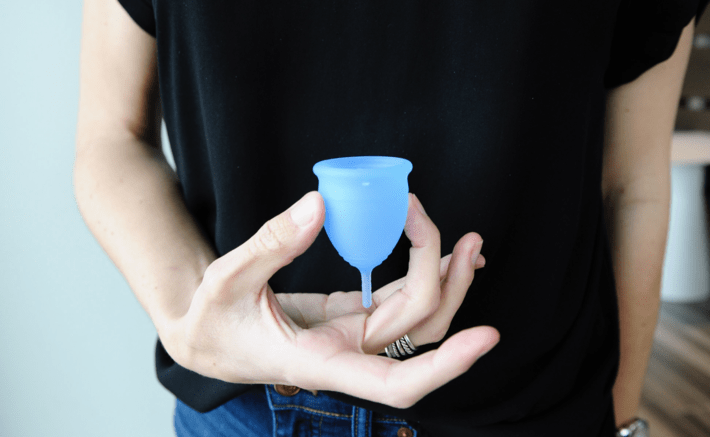
Reusable menstrual products: Best menstrual cups
While it appears that the menstrual cup is making its debut in the here and now, it may have been originally invented as early as 1867. Then, in 1937, an American actress named Leona Chalmers invented what is now the modern-day menstrual cup.
Made out of rubber, Chalmers patent claimed that it wouldn’t be uncomfortable and that women wouldn’t even be able to feel it inside their bodies. Somehow, though, the menstrual cup never fully caught on. And although they’ve become more popular 150 years later, even today, only 11-33% of women are even aware of them.
And some of the hesitation I get. Just like everyone, I initially wondered, Would my bathroom look like a crime scene for a week every month? Would it get stuck? (I know, I know.) Would it be a nightmare in public? What if I leaked?
Suffice it to saw that yeah, some of those fears are warranted. But, a menstrual cup is a totally amazing option—if you find the right one for you, and you learn how to insert it correctly. So, let’s talk about our top picks for comfort, leak-proof-ability (a super technical term I just made up) and ease of use.
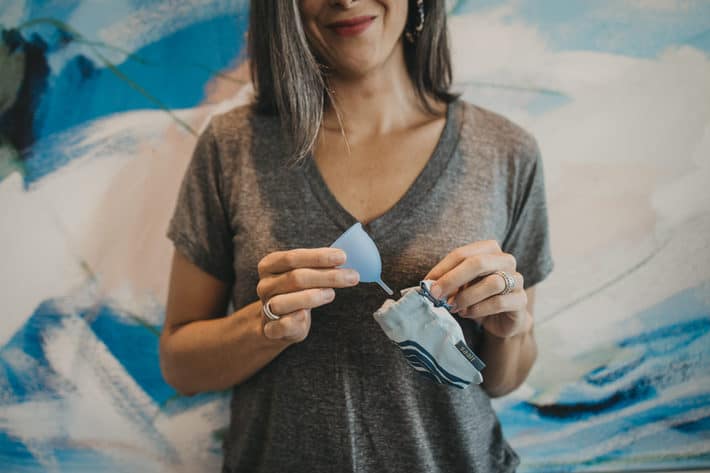
Saalt Menstrual Cup | $29
Saalt is the gold standard when it comes to their ethos to be sustainable and environmentally friendly. On top of that, they give back 2% of their revenues to promote period education in developing nations.
They are also one of the few (if only) 100% USA-made silicone menstrual cups currently produced. The Saalt cups are made of medical-grade silicone, are chemical and toxin-free, and offer up to 12 hours of protection.
I’ve actually been using Saalt Cups for more than three years, and they’re the most comfortable of the period cups I’ve tried. Others are too stiff, making them tricky to fold correctly to insert or making them more painful to remove. Some aren’t reliable when it comes to leakage. And some nobs (that part that you can pull down on) are way too long. With Saalt, if I insert and “seal” correctly, I feel comfortable all day (or night) on my heaviest flow days.
I prefer to pair whatever cup I’m using with some type of period underwear too, for my own sanity. Cups will leak if they get too full or are not inserted correctly. (I’ve actually had a nightmare realized with, you guessed it, a white pants incident!!!)
But my biggest gripe with all period cups—they’re hard to change in public. Unless you’re lucky enough to be changing it in a single-user public bathroom, it’s messy to remove the cup, wipe it clean (which isn’t totally advised—you should rinse it to ensure it can reseal itself) and reinsert while being crammed into a single stall.
But I’ve traveled internationally with it and have changed it in an airplane toilet. So, anything’s possible. You just have to get comfortable with doing what you can. And making sure your hands are clean when inserting and removing. I always carry a travel-sized Branch Basics or unscented Dr. Bronner’s with me for quick washing too.
The Saalt Soft Duo Pack is a great choice to get started—it’s cost-effective and the smaller size allows for ease of use on lighter flow days. They also have a sensitive bladder cup too.
Bottom line? When you get the hang of a period cup it’s can be straight-up GLORIOUS. 12 hours of protection, no strings hanging down, nothing falling out or leaking, no additional waste and super comfort. It’s like the epitome of set it and forget it.
Pros of the Saalt Reusable Period Cup:
- Made in the USA of medical-grade soft silicone.
- Easy to insert and remove without irritation.
- Come in multiple sizes for different needs (you might be a different size postpartum or want a smaller size for lighter days).
- No leakage if inserted correctly.
- Easier to clean than other cups I’ve tried.
- Detailed, clear instructions on how to use it.
- You can go to the bathroom with the cup still inserted, which is part of what helps it last up to 12 hours.
- It doesn’t carry a smell—some period cups I’ve used seemed to absorb the smell of blood, which isn’t pleasant when you go back to it next month.
- You can easily forget that you have it in. Which is kind of the point of period cups, so win-win.
- So great for travel for all of the above reasons.
- Waste-free (well, not counting the blood it collects, obvs).
- Lasts up to 10 years, which is incredibly cost-effective: Less than $30 one time, instead of $300/year.
- Comes in a “soft” and a teen version, for lots of options.
- You can use it with an IUD, as long as you’re careful when you remove the cup.
Things to consider with the Saalt Cup:
- If you’re not used to period cups, it takes a minute to get comfy figuring out how to insert and wear it.
- Those with tilted uteruses might need extra practice learning how to situated the cup before wearing it all day.
- You’ll get this with any period cup, but removing it can feel like a tiny birth (this is coming from someone who’s never actually given birth, so, grain of salt… pun intended). There’s suction that has to be accounted for.
- I’ve had a few friends say they can’t pee when they have a cup inserted.
- If you’re squeamish about your own blood…period cups might not be for you.
- Changing them in a public bathroom is trickier than a tampon or pad.
- It takes longer, in my experience, when you have to change it than it takes to change a pad or tampon.
- Saalt says you shouldn’t have sex with the cup in.
- Can get annoying after using it for a few days…sometimes I switch to a tampon on day 4 or so…or just period undies on lighter days.
- Sometimes needs to be repositioned like after exercise or using the bathroom.
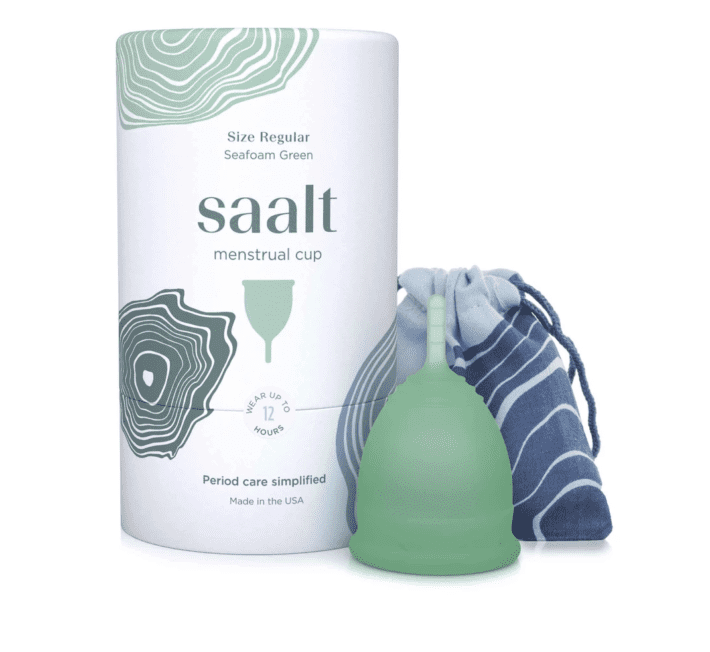
The best traditional menstrual cup we’ve tried. Soft and easy to manipulate, it takes a bit of time to ensure it’s inserted correctly, but then it’s a dream replacement for tampons.
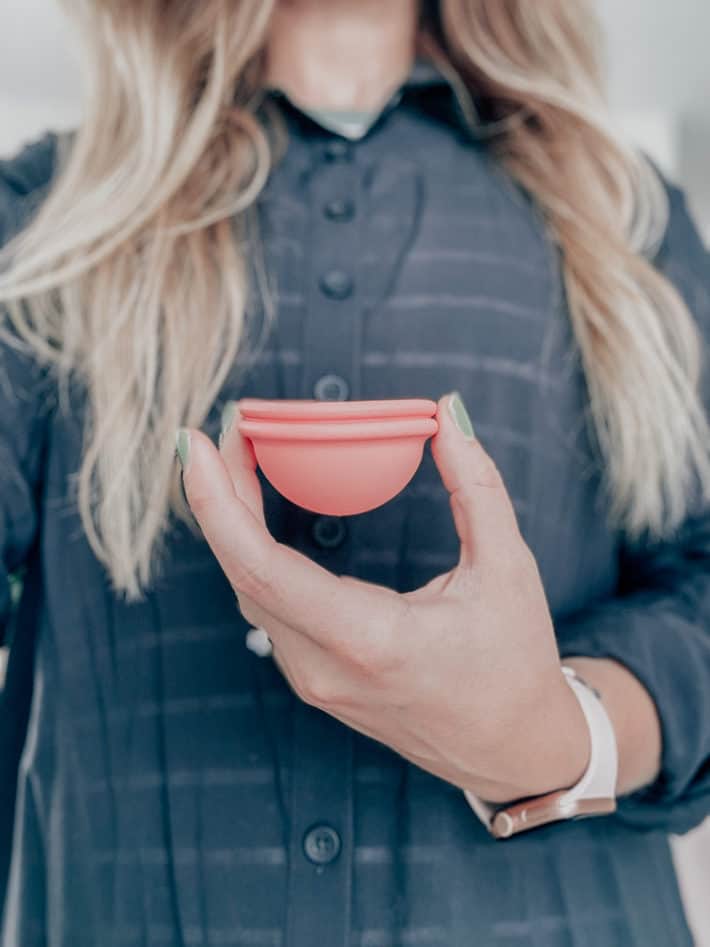
nixit Menstrual Cup | $39
Lisa and I both tried nixit for the first time this year. The premise of this unique cup design is similar to disposable period cups I’ve used in the past and loved (minus the enviro impact), so I was really eager to try this super-soft silicone cup out. It’s technically a menstrual “disc,” and it sits a little higher in the vaginal canal than other cups or a tampon. This makes the suction that other cups utilize unnecessary.
My experience with this cup was great. After using other cups for years, this one was easier to insert—I learned faster and had fewer leaks sooner. Like it worked the second time I tried it, after I understood how to situate it. I still wore period underwear with it, just in case, but I think I might be comfortable with regular underwear after I’ve tested it for a few cycles.
Lisa on the other hand, did have nixit leak, so this is not her go-to. That could have been due to a number of factors, including that Lisa has had two kids and I’ve had none, or it could just not be the best fit for her. But, she loved it as an alternative that you can have sex while wearing (other period cups declare removal is necessary before sex).
Lisa says, “This is by far the most comfortable cup I’ve ever tried…LIKE VELVET! But sadly, it was not reliable enough for me. I tried it three months straight and it leaked every month. I do however feel like I struck gold finding this as an option for keeping sheets clean during sex. I was amazed at how comfortable it was (I didn’t feel a thing, nor did my hubs) and contrary to all my other experiences, it didn’t leak a bit!”
Pros of the nixit Menstrual Cup:
- Ultra soft and flexible. Made in Canada with 100% medical grade BPA-free silicone.
- Super easy to insert and remove. Took me less time to learn than the more traditional cup design. The great visual instructions help too.
- Really thin silicone, to help avoid any discomfort.
- Double rim: Extra protection to ensure your period is leak-free and worry-free.
- No stems or strings, which are a little annoying, and can irritate sensitive skin.
- Holds up to 70 ml of liquid, which beats out much of the competition (others range from 15 to 30 ml—which is 2 to 4 times what a regular tampon holds).
- Lasts up to 12 hours, and you can go to the bathroom with it in.
- You can easily forget that you have it in. I found this one even easier to forget that I was still bleeding.
- Great for travel for all of the above reasons.
- Waste-free.
- You can have sex with nixit in—can’t do that with other menstrual cups!
- You can use it with an IUD, as long as you’re careful when you remove the cup.
- No suction is needed to keep it in place—just your anatomy. That makes removal a little more comfy.
- People who can’t pee with a cup in, might be able to pee with nixit.
Things to consider with the nixit Cup:
- Slightly higher initial cost ($39 vs. $29).
- Only comes in one size…which nixit would list as a pro, since you don’t have to figure out which one is the best fit for you. So yes, it’s easier to choose since there’s only one option, but if this one doesn’t feel like it fits, you’re out of luck.
- This one “leaked” a little more when I went to the bathroom with it in. But reviewers say that “bearing down” with the cup inserted can empty it, so you don’t have to actually remove and reinsert while you’re somewhere like a public bathroom. I haven’t tried this, so I can’t speak to it!
- I can’t find concrete info on how long a nixit lasts before you have to replace it (besides the obvious reasons of a tear or hole).
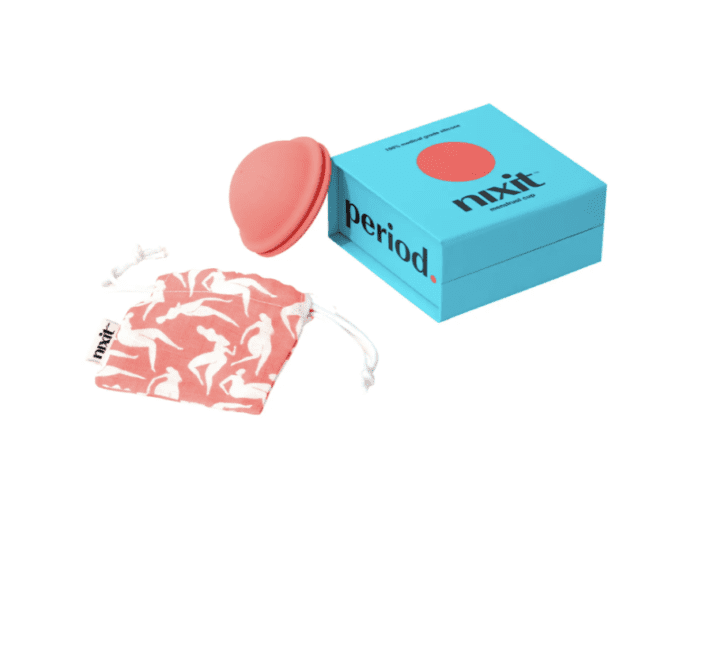
An ultra-soft silicone cup to collect rather than absorb your bleeding. Easy to insert, easy to remove. It has little leakage and can be worn with an IUD.
Reusable menstrual products: Best period underwear
Although there were patents for “menstruation underwear” in 1987, the first period panties similar to the ones we know today came on the market in 2011 under the brand Sexy Period. That was only nine years ago.
But since then, period underwear has exploded. When I first tried them, just a few brands had found a corner of the market. Now, nearly every brand that started with organic cotton tampons or menstrual cups has a period underwear line too!
When I first tried period underwear about five years ago, I was skeptical. I was worried about all the things you would be worried about when you’re bleeding into a garment of clothing. What if I felt like I was in a wet bathing suit? Would it ruin my clothes? Would it feel like a diaper?
No, no and sometimes are my honest answers. But that review comes mostly from my experience with Thinx, a v popular brand that I’m now avoiding because in 2020, an examination of a few pairs of Thinx found of a group of chemicals called PFAS (per- and polyfluoroalkyl substances) in the fabric. PFAS have been linked to infertility and cancer.
So, I tried something else.
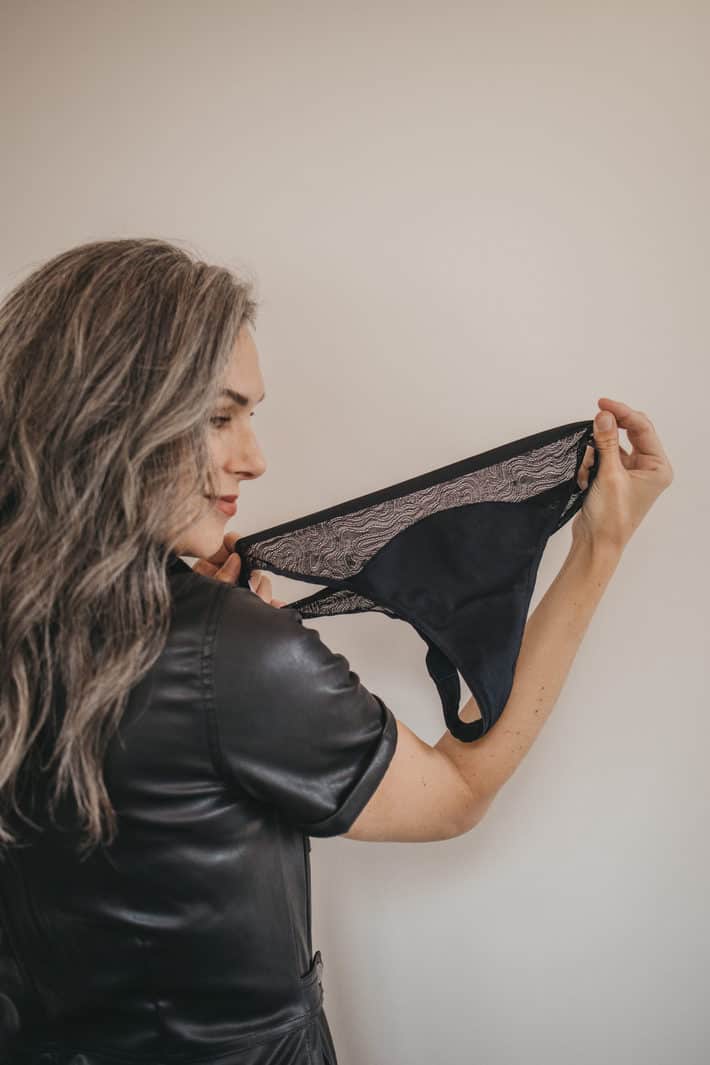
Saalt Wear Period Underwear | $29-$39
Thank goodness for Saalt again. They launched Saalt Wear period underwear in late 2020, and Lisa and I are so on board.
Lisa wears them on days that aren’t even period days. They’re comfortable and breathable, while being incredibly absorbent. The lining is great for collecting any kind of discharge, if you’re ovulating, spotting or have light bladder leaks. I’m told they’re great postpartum too.
Lisa says, “I would give anything to wear Saalt thongs 31 days a month. For all those moments you DID but wish you DIDN’T (i.e. jumped too hard on the kids trampoline, was 3 seconds too late to the toilet, ovulating like a beast…), Saalt steps in and says, I’ve got you, girl. Dry as a bone and comfy. Saalt period undies are a GAME CHANGER.”
I’ve tried a few types of period underwear, and these are the slimmest yet. They do NOT feel like a diaper, even when you’ve bled into them, which isn’t the case with some other brands.
Neither Lisa nor I will wear just period underwear for our heaviest bleeding days, but Saalt offers multiple styles of underwear that are designed to hold 1 to 2 tampons’ worth or 2-3 tampon’s worth. If you’re interested in reusable period products to replace pads, these are the ones for you.
Pros of Saalt Wear period underwear:
- Made with recycled polyester, elastane and spandex.
- Free of PFAS (specifics on this straight from Saalt here).
- Soft, silky feel and multiple styles and colors, including a thong.
- Slim lining that’s actually absorbent.
- So comfy, I forgot I was wearing them (like, I forgot I was bleeding—that’s kind of unheard of). They didn’t ride up either.
- Easier to rinse out than other brands I’ve tried.
- Don’t feel like a diaper, yet actually absorb. I wore just these, no period cup, on day 3 of my period and wasn’t worried about revisiting the bleeding-through-my-pants experience.
- Keeps me drier than other period underwear.
- No odor—my other period underwear do seem to smell after just a few hours.
- You can wear them with an IUD.
- Super cute and dare I say, sexy.
Things to consider with Saalt Wear:
- Initial cost—over time, they’re cheaper than disposable period products, but you do need to invest in a few (or 5) pairs up front, especially if you’re only using them to collect your period.
- Not size inclusive (yet).
- I haven’t had these long enough to speak to the longevity of each style, but one of my pairs did start to come undone at the seam after just one wash.
- Which leads me to the fact that the recommended way to wash is hand wash or in a delicates bag. I know I should, but I’m just not going to do this. So I need them to hold up to a cold-water wash in the washing machine (I will hang them dry, which is recommended).
- You’re bleeding into your underwear—that’ll take a bit to get used to.
- I’m not a major exerciser, but I don’t think these would really be leak-proof at a very intense yoga class or on a long run.
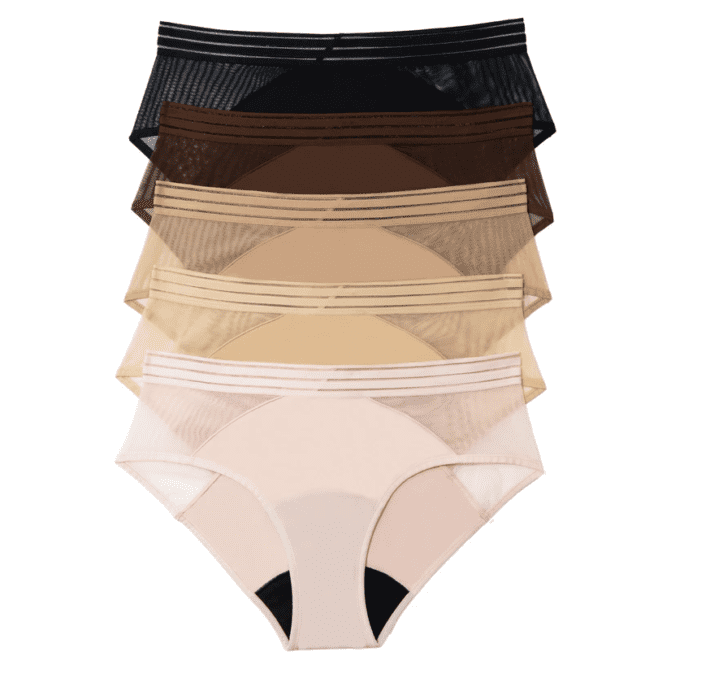
PFAS free period underwear you can depend on (pun intended). Great for bladder leaks, medium to light period days and not feeling like a diaper.
Switching to sustainable options can often feel like a compromise. (I.e. can someone make healthy teeth-whitening strips that actually work?! I just don’t want to brush my teeth with charcoal.) But period undies and menstrual cups are one of those sweet spot products that are actually better for the planet and actually make life easier! #winwin
Are you currently using reusable menstrual products? Which are your go-to?
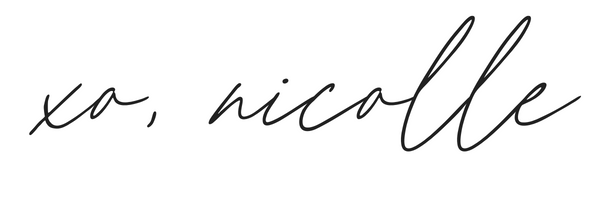
We got a few questions on the free from PFAS-free Saalt Wear, so we reached out to Saalt for comment: “We have tested for fluorine with our products. The product has been through extensive testing through licensed, third-party facilities and results have varied between 0 and 10ppm which is well below the regulatory limit of 100ppm. Because PFAS do not break down, they become increasingly prevalent in the world and products can be exposed to PFAS inadvertently in shipping or manufacturing (kind of like that warning you see on granola bars that says, “manufactured in a facility that also produces peanuts”). This is what we assume may have happened with our products, as Saalt does not use any perfluorinated chemicals in or on our fabrics and we test all fabrics for hazardous substances, not just PFAS. We are passionate about doing the right thing and as we learn more we adjust our testing accordingly.”
TNK Team Note: This article may contain affiliate links, including Amazon affiliate links. As an Amazon Associate, we earn from qualifying purchases. TNK uses affiliate links as a source for revenue to fund operations of the business and to be less dependent on branded content. TNK stands behind all product recommendations. Still have questions about these links or our process? Feel free to email us.
SOURCES
- https://www.prnewswire.com/news-releases/feminine-hygiene-product-market-size-worth-usd-33-78-billion-by-2025-grand-view-research-inc–859748505.html
- https://digital.hbs.edu/platform-rctom/submission/the-ecological-impact-of-feminine-hygiene-products/
- https://www.nationalgeographic.com/environment/2019/09/how-tampons-pads-became-unsustainable-story-of-plastic/#close
- https://www.smithsonianmag.com/innovation/surprising-origins-kotex-pads-180964466/
- https://www.thoughtco.com/history-of-the-tampon
- https://www.popsci.com/menstrual-cups-history-period-care/
- https://patents.google.com/patent/CN88204564U/en?oq=menstruation+undergarment+-disposable
- https://www.racked.com/2016/1/5/10708976/period-underwear-technology
- https://www.popsci.com/story/health/pfas-period-underwear-toxic-chemicals/



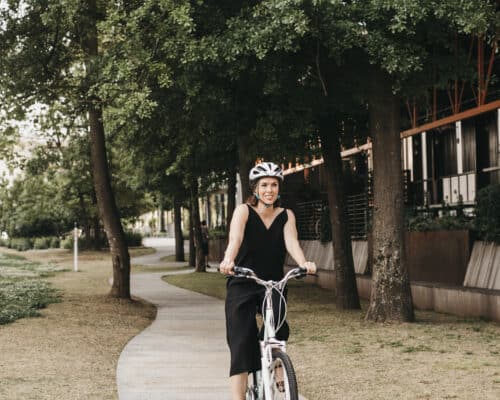
Hannah
August 2, 2020Yes! Totally had leaking problem with Thinx too and so I’m really glad to hear about Rael because I wasn’t sure if all period panties were just going to be the same. Thanks for the review!
Lisa
August 4, 2020Awesome Hannah! So glad this was helpful!
Kari
August 12, 2020I can’t wait to try Rael. Thank you so much for such a detailed review.
Lisa
August 13, 2020Awesome! Let me know what you think! xo, Lisa
Sammy
September 23, 2020I’ve been going back and forth with purchasing a menstrual cup. My biggest fear is it getting stuck…yikes. I’m 37 and have had one vaginal birth. I wasn’t sure which size to get but getting both sizes sounds like a good plan. Maybe I’ll start with the period panties and go from there! Thanks for the info!
Lisa
September 24, 2020Hi Sammy! I have had two vaginal births and I use the regular and it’s a great size. I think Saalt recommends that anyone who has had a vaginal birth should start with the regular. Mine never got stuck if that helps!